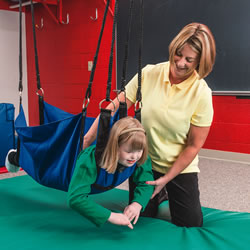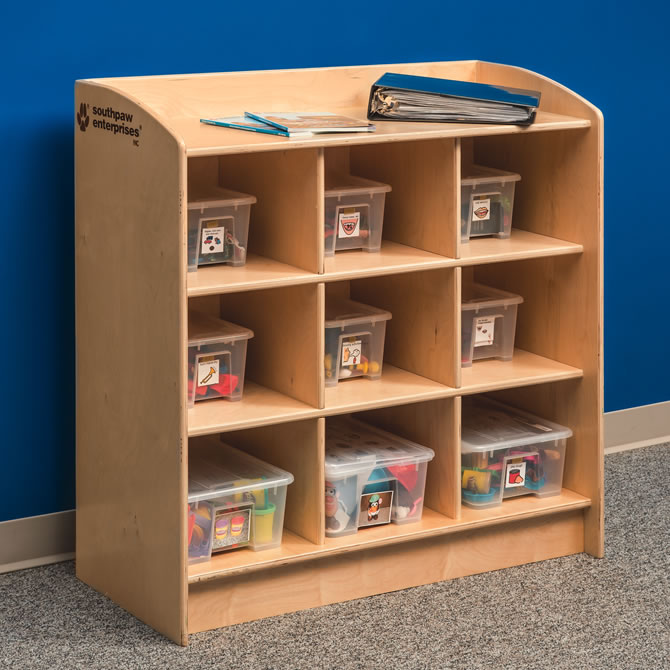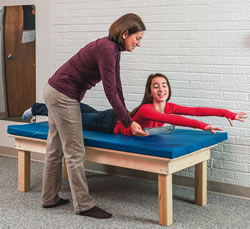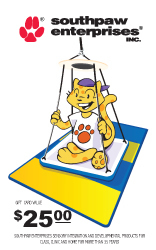|
T-ing Up Activities
 Deanna Macioce, MS, OTR/LRegardless if you are a teacher or a therapist, you find that as you plan activities in the clinic or classroom you often focus in on just one or two benefits to the task at hand. For example, what is the skill being addressed, what will a child learn or what will they improve or focus on? Often times, the one component that is very key and overlooked is positioning. For example, we tend to think that children should always have their work placed on the desk in the middle, but for some children with visual perceptual issues, a simple shift in positioning can make a world of difference. In addition, we think that most seating arrangements should work for all children regardless of height or comfort, strength or stability, and we tend to perform most therapeutic tasks in standing or sitting at a table or desk. However, you may find that just a slight change of using a T-stool, therapy ball or Southpaw's new Togo seat can increase the benefits by addressing core strengthening, balance and vestibular input. Therefore, seating and position are important! Therapy balls are commonplace in most therapy settings, and more and more schools have them available for seating options. Therapy balls come in a variety of sizes and can be inflated differently offering various amounts of vestibular input. When used for sitting and positioning, balls offer just enough movement and bounce to increase alertness, addressing focus and attention. They help improve trunk stability and balance when used dynamically during activities. Having a child sit upright on a therapy ball that allows the child to comfortably place her feet on the floor and participate in Zoomball allows you to address balance, trunk strengthening, and weight shifting with additional vestibular input. So now, an ideal activity for bilateral coordination, shoulder stability, and visual attention just got better! Anyone who has ever heard Carol Kranowitz (author of The Out-of-Sync Child) speak, knows that early on, once seeing the benefits of t-stools, had all of her preschool children sitting on them during circle time. T-stools are a very beneficial piece of equipment that are often overlooked. They are great because anyone of any size can use a properly fitted one. T-stools hone in on really activating the core trunk muscles increasing a child's balance. Because they require so much stability and weight bearing through the legs, when you add an activity with them, such as a bean bag toss where the child has to obtain the bean bags off the ground and toss at a target, the challenge and benefits are numerous. They are also ideal for sitting with increased focus and attention, much like Carol has her preschoolers doing. They do not allow for much slouching and slacking, and a slight wrong shift of weight can cause a child to tip. Southpaw's new Togo seat offers the benefits of both a therapy ball and t-stool in one. It is great at addressing core strengthening and balance with a little bit of vestibular input improving focus and attention. In addition, the seat also comes in two different seat bases, allowing a slight difference in support. In a classroom, the Togo seat offers the ability to keep the wiggly child paying attention to the teacher with a slight bit of movement that is now distracting to the whole class, and takes up less space then a therapy ball. So before you finish your plan on your next activity, see how you can increase the benefits with these fun pieces of equipment. |
|
Getting Started with Occupational Therapy
Alexander Lopiccolo, COTA
Has your child just been diagnosed with Autism? Don't know what to do? Follow these 10 easy steps to begin Occupational Therapy services to increase your child's independence with daily tasks, problem solving skills, core strength, handwriting, self-regulation tools and much more. Your child will be asking to go therapy because OT is so much fun from the play based therapeutic and motivating activities.
1. Schedule an appointment with your child's pediatrician and bring documentation of diagnosis to discuss pediatric Occupational Therapy (OT) clinics in the area.
2. Internet search all of the pediatric OT clinics in or around your city.
3. Call the pediatric OT clinics to confirm they accept your insurance and/or what alternative payment options are available.
4. Contact your insurance company and verify your Occupational Therapy benefits.
5. Confirm if your employer offers a flexible spending account to pay for eligible therapy related services or products that are not covered under your insurance plan.
6. Calculate your budget for out of pocket therapies. Contact community center boards (resource center) or state funding special needs organizations for answers to questions and/or possible financial assistance. Check your state laws for autism coverage as well.
7. Contact pediatric OT clinics in your area and schedule clinic tours. Ask what type of alternative or holistic therapies they offer. A clinic that also offers Music and Speech Therapy is highly recommended.
8. Schedule an evaluation for your child at a clinic that you feel comfortable with and has a good reputation.
9. Review the evaluation results of your child's testing with the Occupational Therapist. Collaborate to write functional goals together, and be sure that the OT develops a personalized therapy plan for your child's specific needs.
10. Begin your child's outlined therapy plan and request a home program to see faster functional outcomes progress right before your eyes!
** This may only apply to patients seeking services in the United States of America **
|
|
Using Multi Sensory Environment to Facilitate Behavior Change
Linda Messbauer, MA, OTR/L
A Multi-Sensory Environment is not just fancy equipment put in a room; it can impact the very spirit and potential for everyone who passes through it. It changes behavior, motivates learning, and soothes the stresses of everyday life. Done properly a MSE will elevate and highlight any therapeutic, recreation, or educational program. It is ideal for children with special needs and seniors with dementia.

A Multi-Sensory Environment is predictable, comfortable and fun and as a result children experience a level of calm and empowerment. As this experience is repeated it builds up their confidence, focus and ability to try new things. Because according to Sigmund Freud's "Pleasure Principle" one wishes to go towards pleasure and avoid pain. These environments provide primary sensory input through the auditory, visual, tactile, vestibular and movement sense. The highly motivating equipment provides stimulation and relaxation at the same time to enable individuals with special needs and other groups such as Autistic children, those with challenging behaviors and self-regulation issues, to learn to modulate their own behavior; As the MSE changes brain arousal levels. The MSE is specially designed to be controlled by both the practitioner and the child or adult allowing for proper amounts of required sensory input without effecting motivation and choice. The MSE provides the positive feedback to elicit change by allowing the individual to focus in an environment that is safe and responsive.
We know that Sensory experiences are vital and are the foundation for development. Our own preferred and unique need for sensory input is our sensory diet. We know that this diet is essential for maintaining our body and brain in readiness for learning. How an individual interacts with their environment is a direct result of how our brain registers, processes, interprets and responds to sensory input. Learning this process is what a Multi-sensory Environment provides; it allows the individual to organize information for use in the natural environment.
 Linda Messbauer, MA, OTR/L www.lmessbauer.com |
|

Click here to get your FREE copy of our new 2014 catalog. |
| New Products |

Helicopter Swing
The Helicopter Swing offers responsive support in a flexion position. The swing can be used lying face down or on the back, and helps the most nervous client gain confidence in swinging.
Details

Southpaw CubbiesOur Cubbies are perfect for organizing your clinic or classroom. The corner cabinet fits snuggly next to the Cubby to help maximize your storage area. Conveniently sized for versatile storage. Storage bins not included. Details  Mat Tables Mat TablesOur Mat Tables are durably constructed with a Baltic Birch base, hardwood supports and a 2" firm foam padding. The standard table size is 60" x 30" x 18". If space is an issue, you can purchase the Folding Mat Table. The Table folds securely against the wall and legs collapse to save space in your room or clinic. Contact us for customized sizes! Details  Composite ICE Mini Rover Elite Composite ICE Mini Rover EliteOur Composite ICE Mini Rover Elite is ideal for school sensory rooms and children's hospitals. Made out of marine grade composite, this Rover is easy to clean and has a matt finish that hides scuffs and scratches. The Rover provides a complete sensory environment that can offer calming input or sensory stimulation to clients anywhere in your facility. The Elite model contains ICE products combined with connections for two Vibro-Acoustic products. Comes complete with the Super Switch and Power Cube that connect to the ICE Bubble Tube and ICE Fiber Optics. Any Southpaw Rover can be adapted with the composite material. Details  Southpaw Gift Card Southpaw Gift CardA Southpaw Gift Card is the perfect gift for all special occasions. We are proud to offer them in $25 denominations. The gift cards will be shipped to the address provided with the order unless otherwise specified. All Gift Cards are valid for 1 year from the date of purchase. Gift Cards are not redeemable for cash. The original Gift Card must accompany the order in which it is to be applied. Details |
 |
|